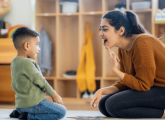Toys are a valuable resource in any early years setting and can be used in a variety of ways. Try these fun toy-themed activities to help children in your setting get creative and develop their Expressive Arts and Design skills…
Invite children to bring in a favourite toy, or a photograph of their chosen toy, and create a portrait of it. Provide an easel, lots of different-coloured paints, pens, charcoal, pastels and chalks, alongside different-sized and varieties of paper, so that children can select their own materials.
Children can turn their portraits into jigsaws by mounting them on card or laminating them, cutting their pictures into six or eight even-sized pieces and challenging a friend to put them back together.
Make a montage of photos of the children’s different favourite toys and their portraits. Turn it into a striking display by creating picture frames using packaging cardboard cut into strips. Decorate these with textured patterns using blunt pencils punched and pressed into the cardboard.
Try this alternative painting toy activity using plastic dinosaurs or animals, washable paint and a water tray full of warm soapy water to clean up afterwards.
Let children paint toys different colours, photograph the results, then wash the paint off. Provide strips of paper so that children can make trails of footprints with the painted toys.
This also works well with plastic cars and trucks. Ensure that children know not to use wooden or metal toys for this activity.
Make toy microphones for children to use in their music and drama play activities. Use a styrofoam or old soft sponge ball as the head and twist wool or string around it to look more authentic.
Attach it to a cardboard tube, painted silver or black. Pass the microphone around the circle and let children take turns to sing a favourite song using it. This will motivate even hesitant singers to take a turn at singing a solo.
Make your own castle construction toy from cardboard tubes. Cut the tubes into 5cm and 10cm lengths. Help children cut four small slots into the top and bottom of each tube, at roughly equal distances, thick enough for the tubes to be slotted into each other.
Let children paint the tubes lots of different bright colours. When dry, challenge them to build a sculpture or castle.
Make some sock puppets for children to use in their music and drama play. Collect some long stripy socks and let children choose one. Show them how to pull it over their hand and up their arm. Can they make a C shape with their hand to create a mouth?
Use a thick felt pen to make dots for eyes and a nose. Remove the socks and provide lots of craft materials, such as pipe-cleaners or wool for hair, googly eyes, small pieces of felt for a nose, moustache, mouth, teeth, ears, and so on.
Alternatively, let children use the Sock Puppets app on a tablet to create a puppet show with a difference.
Use these toy words to create some toy rhythm patterns to sing and clap. Start with doll and pup-pets. Clap and say the words alternately and invite children to join in. Make simple cards showing each word, with an image.
Add a new toy word rhythm such as ted-dy bear and make up some patterns. Can the children sort the cards into new patterns and clap or tap them on a drum?
Create some new musical instruments using clear balloons. Pull the neck of each balloon open and help children to push in different materials such as pompoms, small elastic bands, dry pasta/rice, breakfast cereal, beads or popcorn.
Blow them up to grapefruit size and tie off. Help children to shake them gently and then ‘stop’ using this simple song to the tune of Knees Up Mother Brown:
Shaking the balloons, shaking the balloons,
Shaking, shaking, sounds we’re making,
Now it’s time to ‘stop’.
[Hope they don’t go pop!]
Listen to some of these famous songs about toys with the children. Set up a playlist to use in your setting.
Alternatively, listen to some movements from Jeux d’Enfants by Georges Bizet such as Trumpet and Drum, The Ball, The Doll or The Spinning Top.
Use this song frame to sing about different toys to the tune of Oh When the Saints:
We love our toys, we love our toys,
We love to play with all our toys.
Dolls and teddy bears and robots [or kites and bicycles and skateboards].
We love to play with all our toys.
Let children choose some different toys for the middle line.
Try this echo song about some of the Toy Story characters, sung to the tune of Frere Jacques:
Toy Story (x2)
Woody and Buzz (x2)
Go on some adventures (x2)
Just like us (x2)
Read The Paper Dolls by Julia Donaldson. Show the children how to fold a strip of paper into a concertina and then use paper doll templates to cut out a string of paper dolls like the ones in the story.
Children with good cutting skills can support those who are struggling. Encourage the children to decorate their dolls to all look different.
Can they use them to dramatically re-enact the story, escaping the clutches of the toy dinosaur and the snapping jaws of the oven-glove crocodile?
Set up a toy shop in the role-play corner. Select some different toys to be sold in the shop including soft toys, cars, trains, jigsaws, games and books.
Provide shelves or tables to display the stock. Can children add price tags to the toys? Help children to make labels, a list of opening times and an open and closed sign for the door.
Add shopping bags, purses of money, plastic cards and a till. Encourage children to take turns to go into role as customers and shop assistants.
Talk about how different toys move and invite children to explore this as part of a game based on ‘Beans’. Call out ‘robots’ and ask children to move around as though they have stiff arms and legs and lose power as the batteries run out.
Try ‘ragdolls’ and ask children to suddenly become all bendy and floppy. Try ‘bouncy ball’ and let them bounce around the room or ‘bicycle’, holding pretend handlebars and ‘cycling’ around the room.
Can they spin around on the spot like a spinning top or tumble around like a soft, fluffy teddy bear? Add some dancing music such as Entry of the Gladiators by Josef Fucik and let the fun begin.
Judith Harries is an author and teacher of music and drama, with experience of working with children aged nine months to 11 years.

Dyspraxia – Is it hiding in plain sight in early years?
Editors picks

Speech and language support – Resources for Early Years
Editors picks
